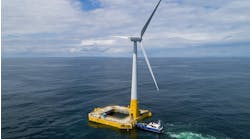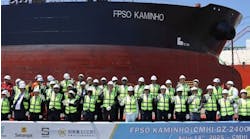Two recently completed studies confirm TotalFinaElf's suggestion to abandon the Frigg field concrete platforms, which straddle the borders of the both the UK and Norwegian continental shelves, should be left in place when production ends in 2004. Only the topsides and jackets will be removed.
There are three concrete gravity base structures on Frigg, TCP2, CDP1, and TP1. The UK and Norwegian governments are seeking agreement for the concrete substructures not to be removed from the other contracting participants in the Ospar Convention.
Olav Olsen consultants and engineers involved in the original designers of Condeep platforms published a study in Offshore Research Focus, which concluded that theoretically it should be possible to re-float modern Condeep structures built after 1990.
But fewer than nine of the 14 Condeep platforms that have been installed offshore Europe can be considered fully designed for re-flotation. Even then, the full extent of deterioration of safety-critical systems and all the hazards that could be encountered during decommissioning were not foreseen at the design stage.
The study found that a failure during re-floating, towing, or demolition could have serious consequences. In the worst cases, a dome bursting or excessive pitch or pop-up failure could cause progressive collapse, leading to disintegration of the structure. Damage might cause the re-floated platform to sink with serious risks to people on board the vessels.
The Atkins UK continental shelf concrete decommissioning study says that 12 of the 250 offshore platforms installed on the UKCS are concrete. The two built in the 1990s, including one hybrid steel/concrete structure, might be considered as fully designed for removal. The other 10 are first generation (some weighing over 500,000 metric tons) built in the 1970s and 1980s. It concludes that the older concrete structures, in particular, will encounter problems making re-flotation uncertain, difficult, and very hazardous.
A significant area of uncertainty surrounds the mechanism of foundation release. Progress needs to be made in subsea technology, says Atkins, so as to place injection wells under the concrete base and to reliably control the re-floating operation before such a hazardous operation could be contemplated. On some platforms, the internal pipework to control re-flotation is badly corroded and new systems would have to be installed to assure reliability of the system. Several key components are within storage cells and inaccessible areas. Remote operating systems will need to be developed to gain access without putting divers' lives at risk.
The new ISO codes for offshore structures to be introduced worldwide soon will include the capability for future decommissioning as an essential design requirement.
12/30/02


